Under the magnifying glass
Under the magnifying glass
This September 2019 exhibition was important for me: it marks a turning point for several reasons.
I was given the opportunity to exhibit in 1500 square meters, with carte blanche.
I pushed the vice to the point of taking care myself, with passion, of the communication and transmission of the exhibition's issues.
I built an exhibition multiplying the media and the place was the vector of several of them.
I borrowed this title, ‘The Dust of Meteors’, from Alain Bashung’s album ‘L’Imprudence’, which with a compelling poetic sense elicits a feeling of impermanence. By using different mediums, he composes a journey connecting different pieces, new and recent, and most of them produced for the actual place where they are being shown, LaVallée.
What are the connections between a surveillance television set turned off, a poster announcing the exhibition within which you are already walking about, a double self-portrait of the artist walking through the walls, collections of found images hijacked irreverently, in situ mural paintings and a series of miscellaneous pictorial proposals?
By summoning a host of public personalities, from politicians to philosophers via activists, Stephan Balleux is proposing a meditation on a possible value of existence.
What about one’s own passage on this earth? What does it mean to exist in a fluid, global world, in transition? How does human existence spread and how does it disappear?
The whole exhibition is built on a system of contradiction and double meaning peculiar to the artist. Oscillating between gravity and humour, between colour and achromia, between figuration and abstraction, between criticism and devotion, the contact between repeated, systematic extremes opens up the field of interpretation, in which ambiguity prevails.

This exhibition was built in an atmospheric way: the themes, the works and the circulation of the spectator became clearer as it was realized. I moved forward without knowing precisely what its purpose will be.


I will present each work in the sense of the reading of the exhibition.
In addition, you can visit this exhibition in a virtual way below.
0
The Dust of Meteors
2019
70 x 100 cm
120 gr Magistra Deluxe Blueblack Paper
Unlimited edition
This edition, with its deliberately ambiguous status, adopts the form of a promotional poster, the only qualification being that finding itself inside the exhibition it is unable to provide any promotion: you are there already.

1 & 2
Self-Portrait with Two Right Eyes
Self-Portrait from Behind with Eleven Fingers
2019
Watercolour with preservation board.
With framing, 165 x 125 cm each figure.
Painted in watercolour on preservation board framed under glass, the two portraits framed from the top of the thighs to the hair, with an empty white background in reserve.
My intention was to create a life-size presence, but the representation is slightly taller than the original. Two boards were needed to include the main part of my anatomy. Each image is divided into two formats, the one framing the face and the neck, the other going from the shoulders to the thighs. This cut in the representation adds a psychological dimension to the image, literally a double portrait (a quadruple one if you add them up).
The height of the hanging is determined by the top of the skull, and coincides with my actual size.
They are placed on the same wall, but on opposite sides, as though the depth of the character belonged to the wall which supports the frames.
The pictorial treatment is a realistic one, with a quasi-impressionistic touch made necessary by the fact that I happen to have freckles (which hardly helps in trying to produce a neo-classical depiction of my face). The posture is almost military, the torso erect, with a T-shirt which makes me look athletic.
The expression is defined by an intention of absence, the gaze isn’t a direct one… Indeed, when you take a closer look you notice that, contrary to the almost photorealist treatment, there is something awry about that gaze…
Only by leaning towards the title of the piece, ‘Self-Portrait with Two Right Eyes’ is the meaning of the work revealed: you discover that in fact the anatomy of the two eyes is oddly similar: the lacrimal caruncle lies on the same side in both eyes.
The reverse of the portrait follows the same logic: the portrait appears with the self-evidence of realism but on a closer look the left hand is seen to include six fingers.
The self-portrait is a genre which pushes representation to the extreme.
A forerunner of the selfie, it is characterised in contrast by a sustained workmanship and an attention to the question of self-representation, and by the age-old sociological one of the position of the artist. In this exhibition it assumes the role of an attendant, and of an admonition: you will have to take a closer, and a more careful look.
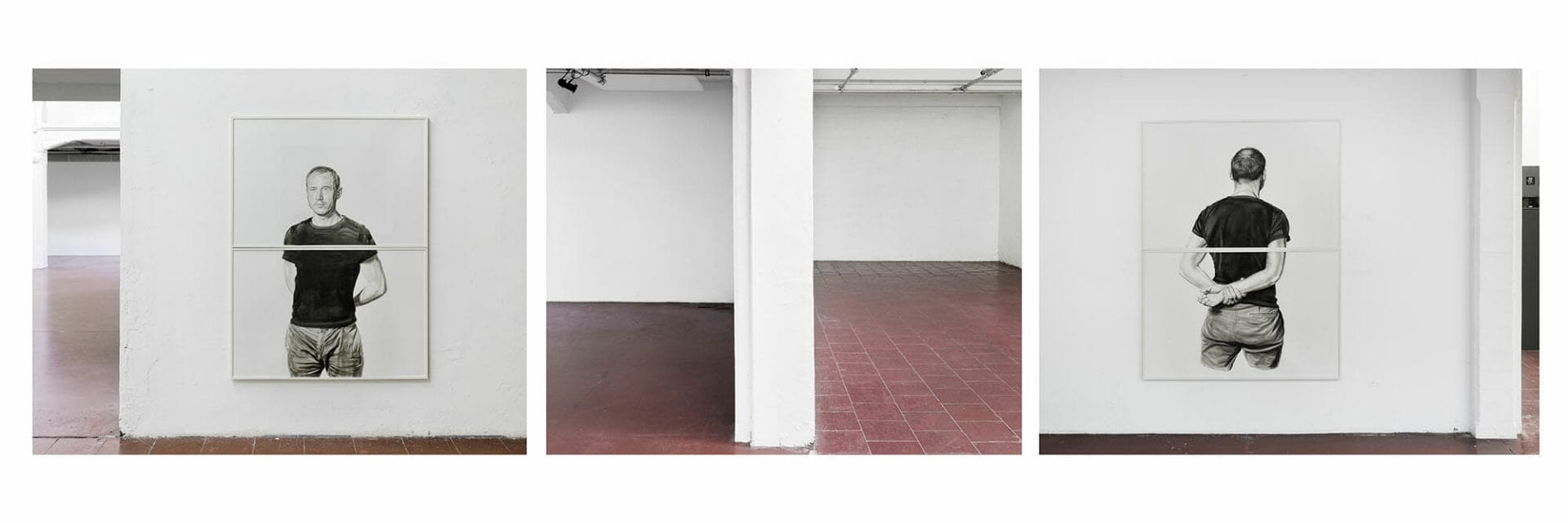
3
Phantasma
2017
Hitachi cathode-ray screen
43.8 cm x 65 cm x 43 cm
I sometimes play with my own perception: I stare intensely at an object for twenty-odd seconds. Very soon the object seems to be moving, becomes blurred, and appears to me as the reflection of itself, as a mirage.
On a long anthracite grey plinth a television screen has been placed.
This apparatus is exactly the same height as the self-portrait to which it turns its back.
The surveillance screen is turned off.
The power cable is absent and yet the screen reveals an image.
A phantom of an image.
The surveillance camera has for years captured and sent to the screen images in real time of the entrance to a location.
This image has printed itself on to the cathode-ray screen: one of the longest exposure times in the history of photography.
‘Phantasma’ is the transcription of a Greek word meaning ‘appearance’, ‘phantom’ — and also ‘image, simulacrum’.

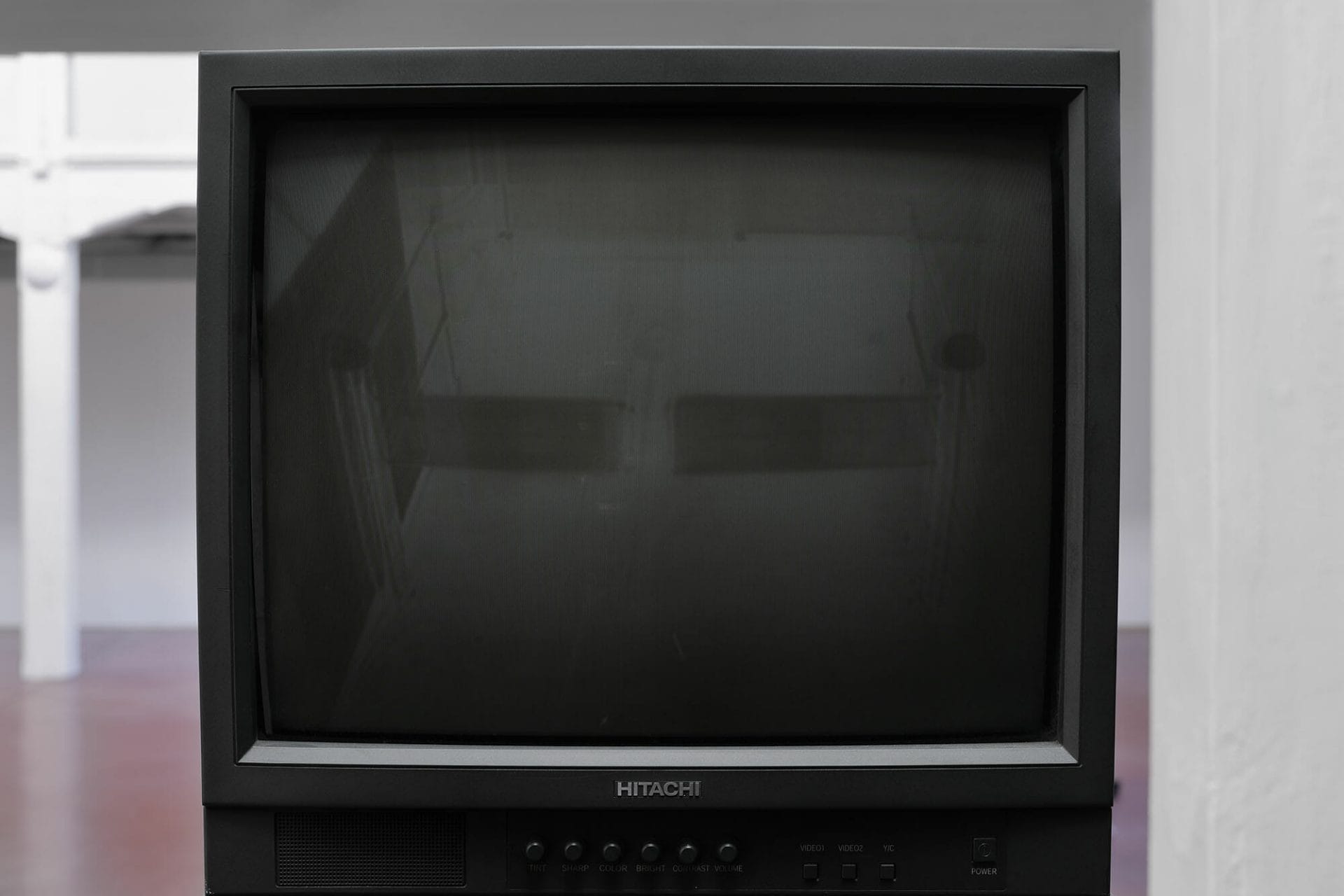
4
Cover
2019
Diptych
170 x 120 cm each
Painter blanket, frame
This installation may seem incongruous when compared with the surrounding works, but as John Goodman said in ‘The Big Lebowski’, ‘It really tied the room together’.
First, their arrangement in space is related to the two recesses in the wall hosting them, and then by a play of analogy between the colour and the static which the screen next to it could produce, and last to the reflection of the found image at the back of the space.
When looking for tarpaulins to protect the floor in the exhibition venue, I fell on those blankets which seemed more ecological than the plastic of disposable tarpaulins. The texture of that fabric is phenomenal: it is made up of thousands of disparate pieces of fabric, and the whole resembles the noise of a screen, or a star-studded sky.
I was also moved when I looked at the object’s name in the shop: ‘painter blanket’. Could it be that there are blankets specific to the people of my profession, by which only we as painters would be protected?

5
Figure
2018
Found image
12.4 x 8.4 cm
Through a simple action with a found image, a ninety degree tilting, the perception of the topic of the image is inverted: starting from a collector’s illustration type documentary image of a castle in Belgium and its reflection in its moat, we find ourselves, at a respectable distance, facing a human figure.
This image had immediately struck me through its capacity, not to evoke a figure, but rather to embody it beyond any doubt.
This is the first piece that found its place in the exhibition: it can only be seen initially from a distance, to give perception time to adjust to the play of the gaze which it demands.


6
Tapetum Lucidum
25 watercolour drawings on paper, steel, magnets
76 x 56cm
2019
‘Tapetum lucidum (a Latin phrase meaning “bright tapestry”), also called “tapis clair” in French, is a reflective surface in the fundus of the eye, which can more precisely be located in the choroidea, immediately behind the retina, i.e. inside the retina itself. […] The eyes of numerous vertebrates include a tapetum lucidum. It makes it possible to augment through reflection, the quantity of light picked up by the retina, hence the eye’s sensitivity to light. […] Human beings do not have a tapetum lucidum, and their night vision is mediocre.’ (Wikipedia French)
Those drawings represent and invoke public personalities belonging to various fields of society: artist, philosopher, sociologist, historian, musician, etc.
Their heads are floating in the void like plaster funeral masks placed on a wall. Their retinas are white, the reserve of the white of the paper housing them: related to the title of the installation, they are literally those who see in the dark.
An invocation of a series of societal positions, this installation invites us to take an interest in the work of each of these persons, with regard to an aspiration towards an emancipation of the human condition.
I consider this installation as fan art, my Pantheon, my own Wall of Fame.

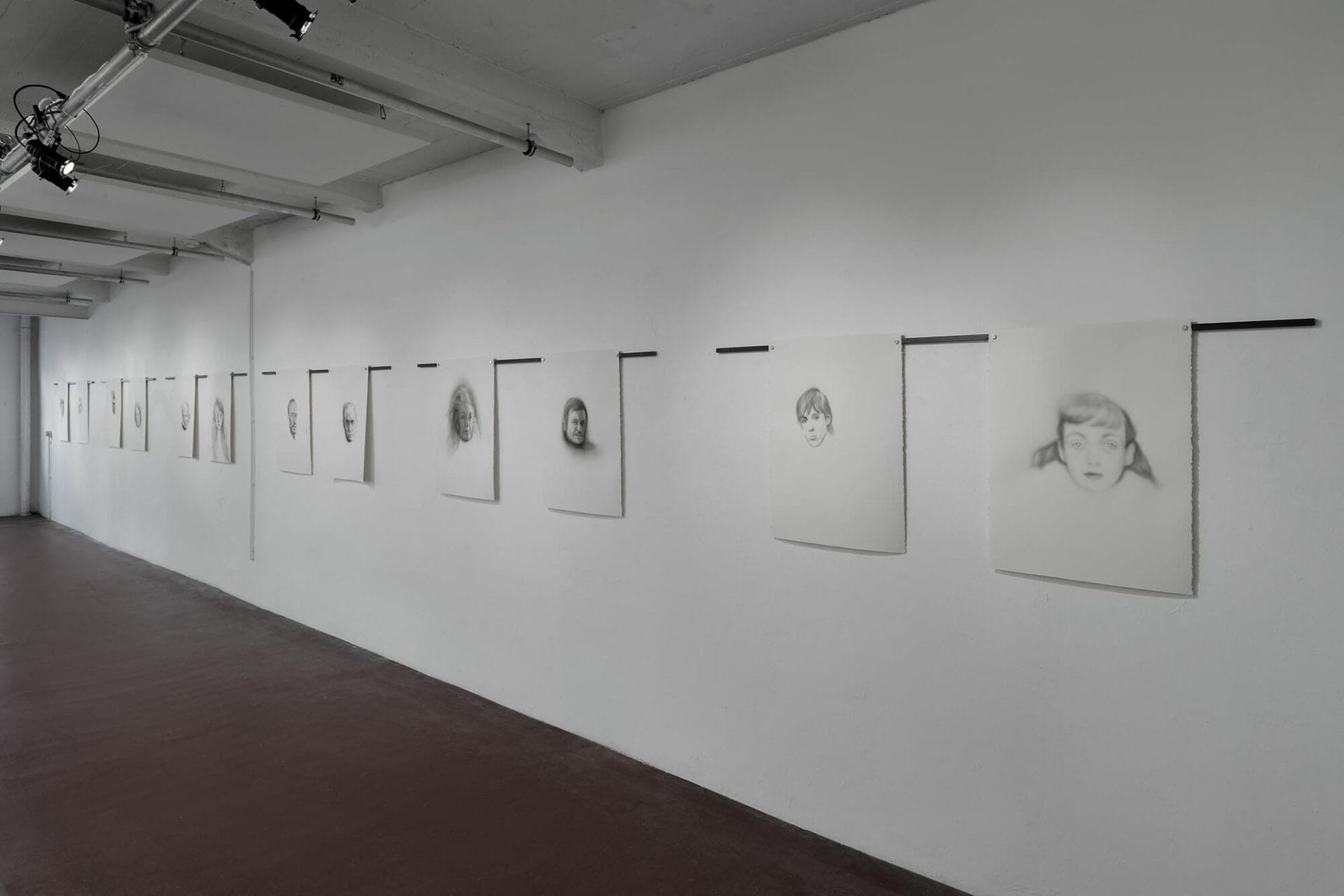

With Glenn Gould, Beyoncé, Samuel Beckett, Sally Mann, Arthur Schopenhauer, Kate Tempest, Hans Belting, Aby Warburg, Rebecca Solnitt, Andreï Tarkovski, Iggy Pop, Marguerite Duras, Bernard Stiegler, Roald Amundsen, Barbara Hannigan, Jean Genet, Beth Gibbons, Harold Pinter, Susan Sontag, Peter Sloterdijk, Polly Jean Harvey, Otto Dix , Virginie Despentes, Pawel Tchelitchew, Elvis Presley.
7
Heraclitus’ Waterfall
2019
620 x 200 cm
Oil on canvas
A narrow painting, 6 metres tall, is placed at an angle against the room’s concrete structure; in spite of its monumentality, it seems to be unstable and waiting to be raised.
Representing a waterfall within which are embedded a series of human heads, it allows us to recognise some emblematic characters: from top to bottom and from left to right are the heads of Friedrich Nietzsche, Noam Chomsky, Bernard Stiegler, John Berger, Samuel Beckett, Gilles Deleuze, Susan Sontag, Clément Rosset, Sony Labou Tansi, Ludwig Wittgenstein, Virginia Woolf, Hervé Guibert, Rebecca Solnit and Rainer Maria Rilke.
This painting was conceived thinking of the sculpted heads on Mount Rushmore, a monument that exemplifies the human being’s will to fashion nature in his/her image.
By invoking in a transhistorical manner a series of emblematic figures acting as landmarks on societal questions rocking today’s civic society, they become so many points of reference in a world that is full of upheavals, an invitation for spectators to study them, question them, find inspiration in them. This painting is a kind of non exhaustive genealogical tree of the idea of a societal stand. The people represented are there to invoke a positioning, a landmark, an attitude towards the present.
Far from wishing to make an installation of ideological propaganda, it is a question of
creating images to reflect on, both through the artistic proposal that is shown and through the elements making it up: the icons invoked are resolutions through images of concepts addressed by those individuals, such as the Anthropocene, the relationship between reality and phantasmagoria, the perception of sensible reality, empathy, the relationship to oneself, etc.

8
The Dust of Meteors
2019
Acrylic mural painting
430 x 1120cm
Produced with an airbrush on the wall itself, this mural painting represents an incandescent being. The treatment in hues different from that of fire gives this fresco an aspect that is contrary to that of its source and evokes a series of meteorites, or else a cave.
This painting was conceived as a sensory experience : the luminosity of the installation is deliberately low and this creates an intimate character, contrasting with the monumental size of the work. The perception of the painting evolves as one approaches the support, an effect of surprise eventuates when one discovers the reality of the pictorial surface.
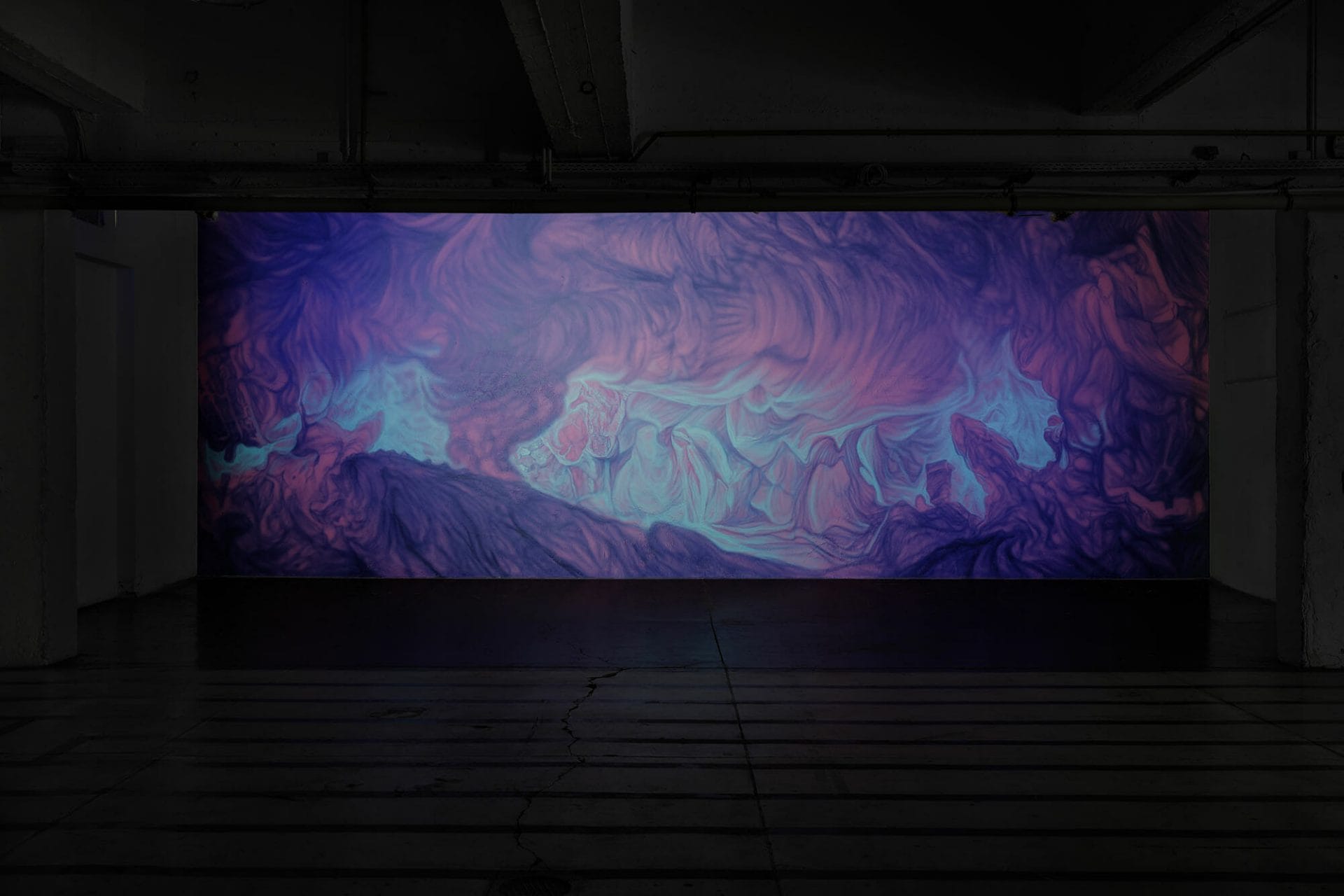
9
Janus
2019
Gouache on wall
350 x 2700 cm
This fresco has been composed following the principle of anamorphosis.
An anamorphosis is ‘a reversible distortion of an image, using an optical system — for instance a curved mirror — or a mathematical transformation. […] The word derives from Greek ajnamorfwvein, anamorphoein, “to transform”.’ (Wikipedia French).
The images painted on the wall only reveal themselves from two points of view, at both ends of the support.
What is at stake in this mural painting is the representation of a contemporary Janus, the bifrons (two-headed) Roman god of beginnings and ends, of choices and doors.
I borrowed the image of two present-day public personalities carrying strong, contrasting societal values.
Likewise, this makes it possible for two different essences of embodiment to meet: that of reality (contemporary politics) and that of fiction (embodiment of mythological or fictional figures).
Theresa May and Tilda Swinton have become for this occasion the union of antinomic symbolic figures.
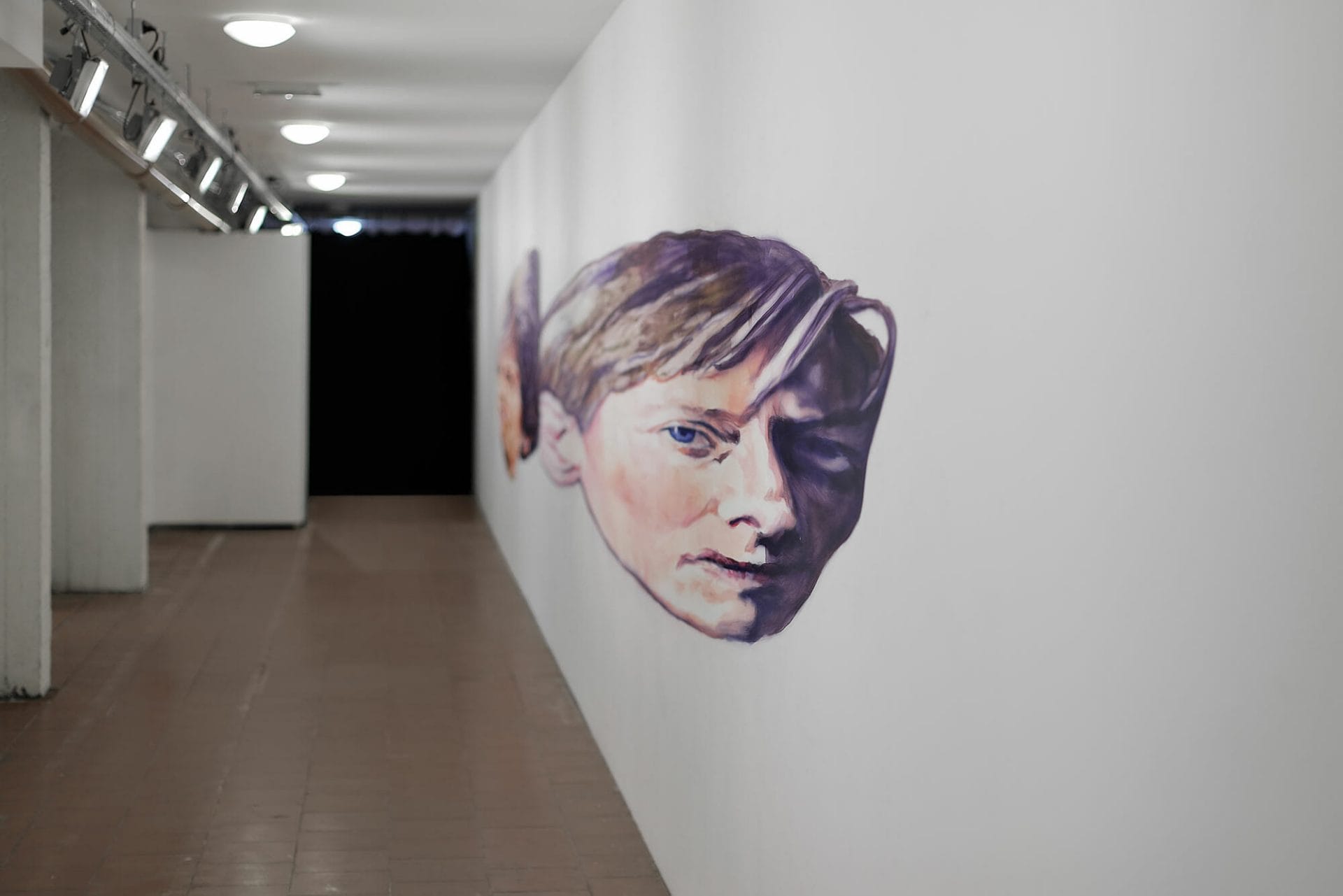

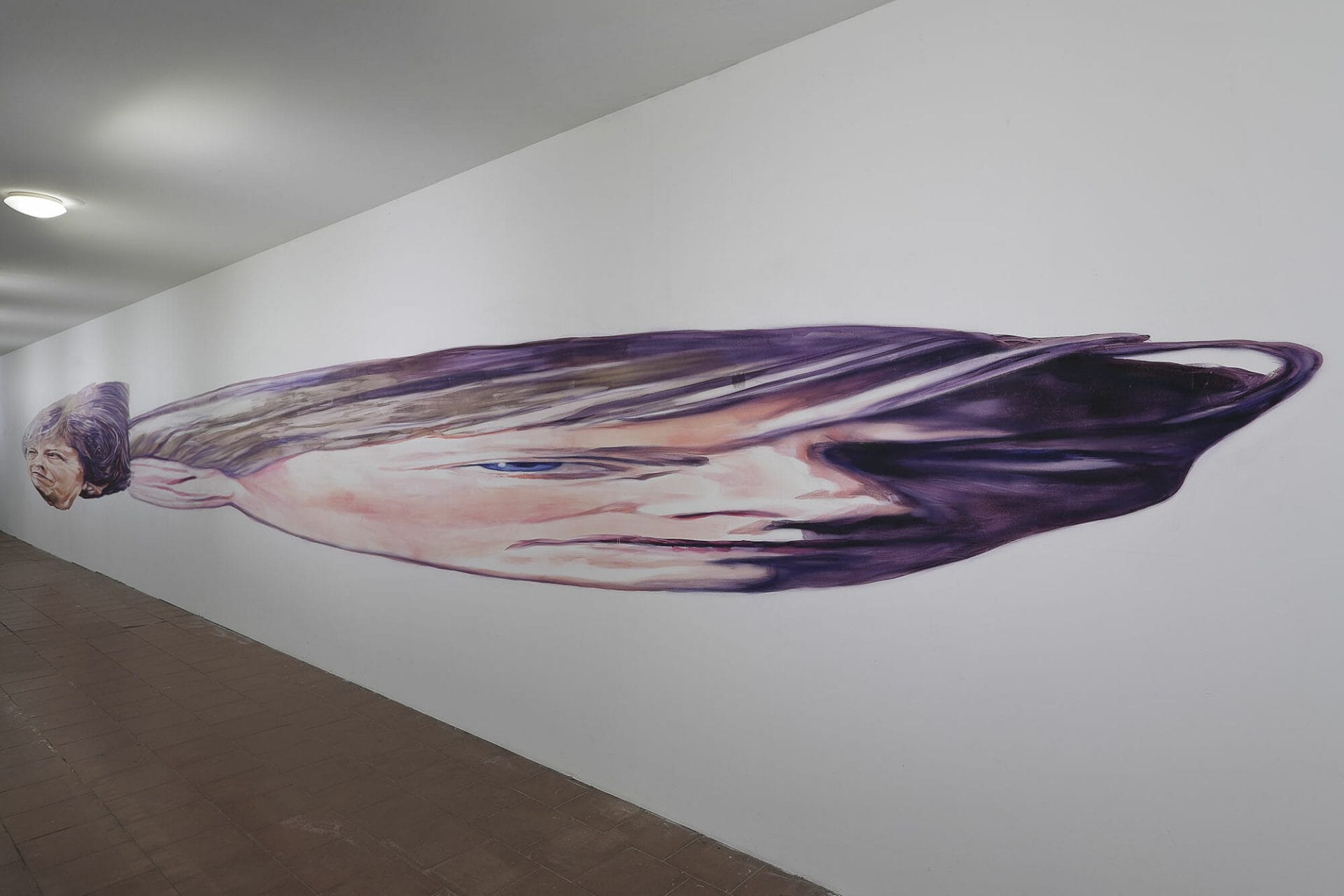

10
CeleBelgians
2019
Intervention a document
43.5 x 36 cm each frame
Images found in a book from the early 20th century entitled La Belgique aujourd’hui, which eulogises the Belgians who built that industrial and colonial nation, these superlatively well printed portraits represent individuals at the apex of the societal pyramid. With regard to a necessary deconstruction of the values and the historical data of that period, the interventions’ irreverent interventions question the idea of posterity.
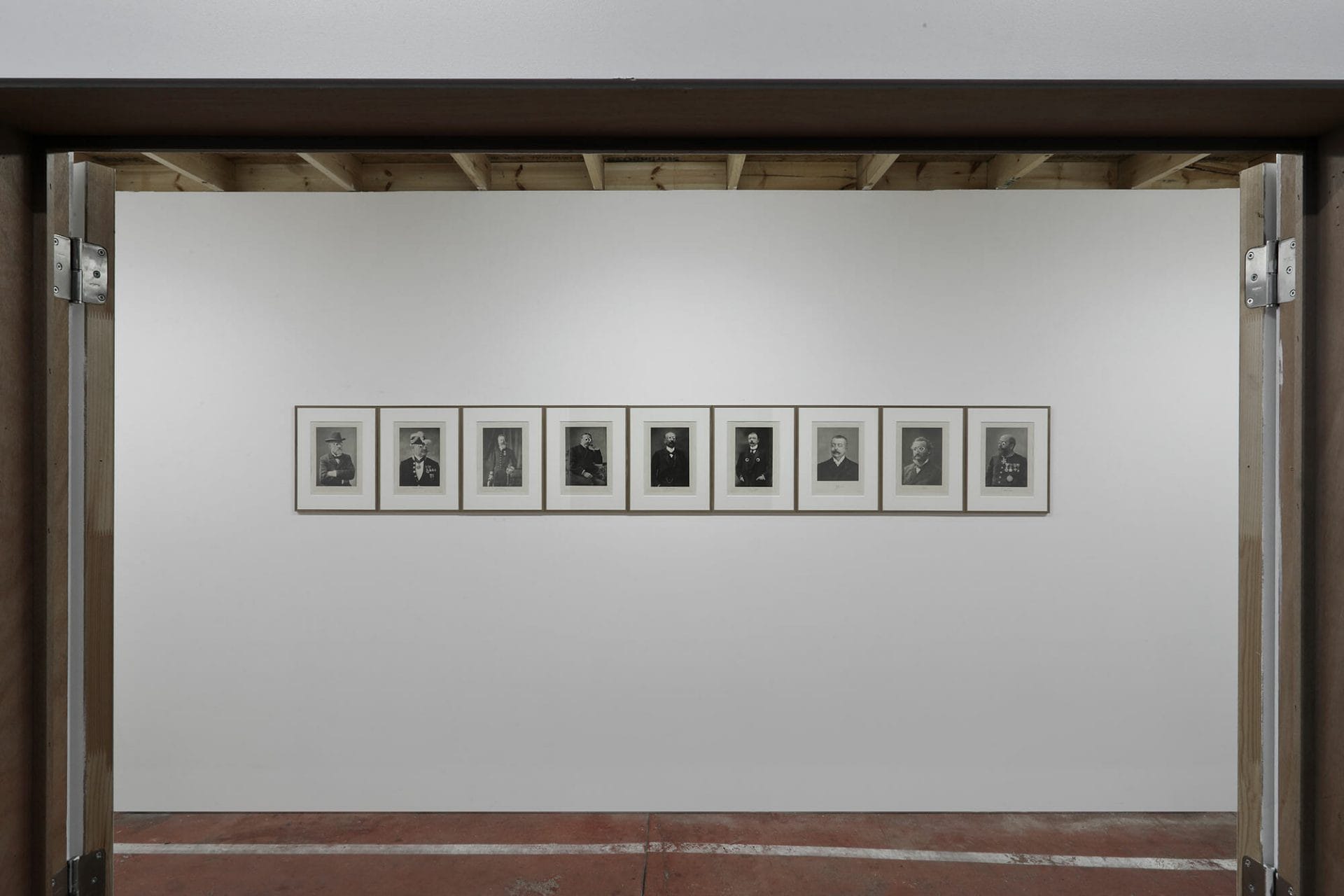

11
The Field
2019
Triptych, 300 x 390 cm and twice 300 x 200 cm
Oil on canvas
Steel presentation device
The work presented is a monumental oil painting arranged as a triptych, including a central 3 metre by 4 metre painting, flanked on both sides by three metre by two metre paintings, forming a 800 by 300 cm whole. The paintings are arranged in reference to a slightly opened altarpiece. The three paintings display the same scene, developing logically from one painting to the next. The size of the work posits painting as a spectacle, even at the risk of verging on kitsch. Its system of presentation, which is the first thing the spectator sees when he enters the room in which the work is presented, exemplifies this connection with the spectacle: the painting is supported by a metal structure which brings to mind the structures in cinema or theatre sets. The system is designed to be invisible to a spectator stationed at a certain distance, which gives the gaze a sense that the canvas is floating five centimetres away from the floor.
In the central painting, exactly in the centre, a full-length character is represented, his size actually a bit bigger than the original, in a play of reference to portraits of aristocrats in the 19th century. Within the same logic, the landscape round him refers to Dutch landscapes painted in the 17th century by Jacob van Ruysdael, who put clouds centre stage in a pervasive way, as well as spectacular sunsets, which to us evoke Hollywood propaganda.
The person represented is a current media personality, known among others for his active presence on social networks. Through his expressive character, differing from photography, this personality can be recognised immediately, provided the spectator shares the same media sphere. Should the opposite occur, he will take on a more anonymous stature.
As the gaze on the character moves towards the bottom of the canvas, the body literally dissolves : the face, the jacket, the shirt, the skin, the rib cage, the viscera, the muscles, the tendons, the bones are one after the other represented then subtracted from sight until they disappear completely. The painting is a contemporary representation of a recurrent motif in spiritualist photography as well as in literature and the cinema, that of the phantom, the ghost. Phantoms are per se an allegory used by a number of painters to talk about the phenomenon of the visible: I will mention in particular Bruno Perramant.
Painting is treated in an ambiguous manner: the image has been painted in a very figurative (or even illustrative) fashion, in a manner that recalls that of Soviet socialist realism, the heroic ideological aspect of which might be mentioned. The anatomical fragments are represented quite accurately, while avoiding the pitfalls of an anatomy lesson.
The image represented was constructed out of various borrowings from a vast number of iconographic sources: the face is a mixture of various press photographs, the flesh of the body and the hands belong to the artist himself, the landscape was captured by the artist using a smartphone in Brabant Wallon, and the various pieces of anatomy come out of a celebrated 18th century illustrated medical treatise, published by a widely known publisher. I should also mention that the posture is that of the stereotype within the genre of the anatomical model since Erasmus.
The choice of a reference to current affairs aims at allowing the work to address the present time, so that by extension every person who looks at the work can feel involved, erasing social and cultural discriminations.
The painted image was conceived to be comprehended without ambiguity. Touching at the same time the modalities of allegory, of vanity, the landscape genre, the scientific treatise or the painting of moral subjects, it hopes to fluctuate between the genres and to encourage debate and thinking.
This painting is meant to be a reflection on the impermanence of life, something of a Memento Mori.
It represents a man as he disappears, and reminds us of the fate of all living forms: the law of entropy is a hard one, but it is the law.


















